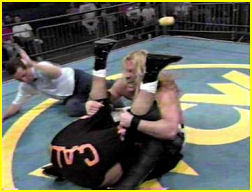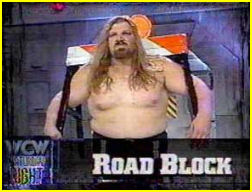
| ||
|
When A&E was making multiple documentaries on the spectacle and The Tonight Show was doing more to bring heat to feuds than three hours of prime time television, you had to know that professional wrestling was getting too big to sustain itself. The years of 1996 to roughly 2000 were the era that turnbuckle historians commonly classify as the “years where Hulkamania ran too wild for its own good.” Everybody was a fan in those days, including you. Karl Malone gave the Diamond Cutter sign during an NBA Finals game, Jay Leno wrestled in a Pay-Per-View main event, and the Dalai Lama tried to free Tibet in a “What does everybody WANT!?” Al Snow shirt. From the cover of the USA Today to the desks in Mrs. Schnabel’s Algebra I class, everyone and everything were extolling the virtues of their favorite wrestlers. Didn’t like it? Well I’ve got two words for you: “Oh you didn’t know?” No, that’s not it. “Snap into a Slim Jim?” I think so. Somewhere between the luchadores' arrival and Mark Henry’s beloved little hand, we reached a point where wrestling went totally out of control. The mere reality that WCW thought it was a good idea to have Dennis Rodman and Karl Malone headline a Pay-Per-View, that these athletes thought it was a good idea to do so, and that I thought it was a better idea to pay $30 to watch it all shows that we had all completely lost our minds. While a previous generation sacrificed their shoe leather for the soldiers and had welders turn their refrigerators into bombs, my generation sacrificed two hours of sunshine and socializing to watch Dean Malenko beat the Silver King in Boise on WCW Thunder. At least the heroes’ sacrifices at Normandy weren't for naught.
WCW Saturday Night. Saturday Night apparently was the mainstay show of World Championship Wrestling for years, until Eric Bischoff somehow convinced Ted Turner to cut out three hours of Atlanta Braves’ batting practice and air a wrestling program on Monday nights. As Monday and eventually Thursday became the prime air-time for the promotion, one would have assumed that the company would have pulled the plug on their two hour rasslin’ show filmed in someone’s basement in Atlanta. Instead, WCW rolled out a show that was something of a bastard amalgamation of an open tryout and America’s Funniest Home Steroids. After being pressured by Jim Ross and half the kids on the school bus to believe that wrestling needed to be watched all the time, I finally watched WCW Saturday Night one time. I taped the program, had some friends over, and naively expected it to feature the Nitro girls and superstars like Scott Hall and Goldberg. Instead, it featured Public Enemy and superstars like Frankie Lancaster and Hardbody Harrison. And I couldn’t have been more thrilled. When Public Enemy was in a match, there were only two things that people wanted to see: A table get smashed and a naked woman (few Public Enemy fans had witnessed the latter.) But as if to prove that even the cameramen were being auditioned, as the crashing of a table was heard, the WCW Saturday Night cameras were firmly focused on the fans. Things only went up from there. Main page icon El Dandy shook his hand in agony after a routine knife edge chop, two jobbers had each other by the lips before the referee had to chop their arms apart (forever known as “the double lip grab”), and Kendall Windham cleverly avoided a would-be attacker’s post-Irish whip move by grabbing the ropes and falling on his face. But the absolute best moment of the night came when a large individual named "Roadblock" was going for what had to be his only career victory. Apparently Mr. Block’s finisher was to stand on the ring apron and then fall backwards over the ropes and onto his opponent. As the crowd of six people worked themselves into some sort of applause sign-induced frenzy, announcer Mike Tenay screamed at us “WE’VE SEEN THIS BEFORE!” Despite the obvious fact that nobody anywhere had ever seen this before, Tenay was doing his best to get us primed…..for the ultimate payoff when Roadblock became tangled in the ropes and fell awkwardly in the vicinity of his fallen opponent.
Eventually, WCW ditched their signature blue and yellow ring and finally, the show altogether. Some might argue that the show had died years before, when WCW moved the main event talent to Monday nights and let the show fester. But we all know when the death knell truly rang on the show: When a specimen of supernatural obesity named Roadblock got awesomely tangled up in the ring ropes and the only people to witness it were some comedy-starved adolescents in an outpost known as Leonard, North Dakota. With the show’s penultimate moment passing so quietly in the night, the station should have hurriedly switched back to Jeff Blauser whacking pitches from a JUGS machine and respectfully retired what will forever be remembered as WCW’s best program by a mile. |

Leonardite.com

